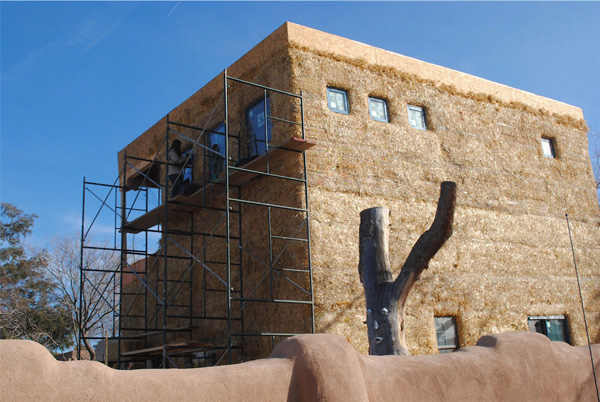
“Do your heating bills drive you crazy in the winter? Are you and your family sweltering inside your home in the summer? Do you want to improve the look of your home? Do you need new electrical outlets in your house, but can’t afford it? What if there was a ‘green’ and affordable way to solve all of this? We think there is. It’s called a ‘straw bale retrofit’, and we think you’ll love it.
There are multiple ways a straw bale retrofit can affect your home, one of them is turning it into a place of efficiency and beauty. Insulation. Electrical. Mechanical. Doors and windows. Aesthetics. Additional square footage. And so on. At our workshop, we will give you a full listing of the advantages and some challenges–of a straw bale retrofit and how doing so could help your own home.
Like most other building methods, you could stumble through a straw bale retrofit yourself and probably make a good job of it. However, we’ve been doing it for a long time and have learned a lot about the pitfalls, ways of making it easier, things to avoid, and a whole variety of different retrofit options for different styles of houses. The workshop will guide you through those things we’ve learned–and you’ll gain the advantage of our years’ worth of experience.
At this workshop, we will not only show you the how-to’s of a straw bale retrofit but we’ll also point out and demonstrate the many ways you can optimize such a building method. Do you want to make your windows bigger but not lose energy efficiency? Is there an area around your house you want to create shade while keeping the passive solar gain? Will moisture and animals really be kept out of the bales? How about stucco cracking on two-story retrofits, or the options of retrofitting a mobile home? We’ll tell you what we’ve learned about how to do straw bales right!
Sign up now for the Straw Bale House Retrofit Workshop in Albuquerque on April 25th and 26th. Cost is $85 for both days.”

I have a question about retrofitting with Straw bales. Is it possible to retrofit with bales on the INTERIOR of a stick frame house? Specifically, a stick frame house wrapped with brick veneer. As with a typical brick veneer, there is an airspace between the house framing and the brick. I realize I would lose some interior space but that’s okay with me. Here’s my proposal. Remove drywall from interior of wall, remove existing insulation and wiring, stick strawbales into the framed wall, notching where needed, so that the wall cavity would be insulated with straw. then run new wiring on inside of straw bale wall. The outside edge of the straw wall would be adjacent to the plywood sheathing attached to the framing. Would this trap moisture? Would I somehow need to plaster the backside of the bale before sticking into the wall? Has this been done before? Thanks for any comments/thoughts.
Something very similar to what you describe is shown in my DVD A Sampler of Alternative Homes, available at http://greenhomebuilding.com/store.htm
With airspace between the brick veneer and the studs, I would not expect condensation at that level. Plastering the backside of the bales would be a good idea for several reasons: earthen plaster can deal with humidity well, and this would contribute to fire safety.
We have a 16×80 single wide mobile home on a permanent foundation. Would like to add a livable “sunspace” on the south side using strawbale construction. Is it allowable in New Mexico. Also have questions about using cargo containers and strawbale
Yes, you should be able to build a strawbale sunspace onto your “mobile” home in New Mexico, with drawings stamped by an architect or engineer. NM has a state-based building code, so wherever you are in the state, the code applies, and some cities (like Albuquerque, Santa Fe, & Las Cruces) might have slightly more stringent codes.
Likewise, you could wrap a cargo container with bales to insulate it, although I don’t personally know of anyone who has done this (yet). This would probably not require a building permit. Obviously, if you choose the wrapping option, you will need to put the bales on a proper foundation, build a roof over them, and plaster them. I would also recommend plastering the inside of the bales, which would touch the container, with a thick coat of mud plaster. The metal will cause moisture to condense on its surface, and over time cause the bales to rot. Adding a mud layer in between (NOT cement stucco), would absorb the moisture and help to mitigate negative effects on the straw. Personally I would suggest doing more research on this topic before moving ahead with the project.
Best Regards,
Catherine Wanek